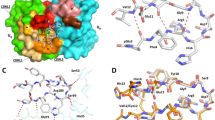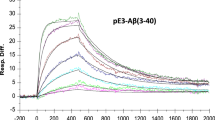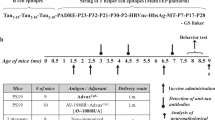Abstract
Immunization of transgenic mouse models of Alzheimer disease using amyloid-β peptide (Aβ) reduces both the Alzheimer disease–like neuropathology and the spatial memory impairments of these mice. However, a therapeutic trial of immunization with Aβ42 in humans was discontinued because a few patients developed significant meningo-encephalitic cellular inflammatory reactions. Here we show that beneficial effects in mice arise from antibodies selectively directed against residues 4–10 of Aβ42, and that these antibodies inhibit both Aβ fibrillogenesis and cytotoxicity without eliciting an inflammatory response. These findings provide the basis for improved immunization antigens as well as attempts to design small-molecule mimics as alternative therapies.
This is a preview of subscription content, access via your institution
Access options
Subscribe to this journal
Receive 12 print issues and online access
$209.00 per year
only $17.42 per issue
Buy this article
- Purchase on Springer Link
- Instant access to full article PDF
Prices may be subject to local taxes which are calculated during checkout





Similar content being viewed by others
References
Small, D.H., Mok, S.S. & Bornstein, J.C. Alzheimer's disease and Aβ-toxicity: From top to bottom. Nature Rev. Neurosci. 2, 595–598 (2001).
Chishti, M.A. et al. Early-onset amyloid deposition and cognitive deficits in transgenic mice expressing a double mutant form of amyloid precursor protein 695. J. Biol. Chem. 276, 21562–21570 (2001).
Janus, C. et al. Aβ peptide immunization reduces behavioural impairment and plaques in a model of Alzheimer's disease. Nature 408, 979–982 (2000).
Schenk, D. et al. Immunization with amyloid-β attenuates Alzheimer-disease-like pathology in the PDAPP mouse. Nature 400, 173–177 (1999).
Morgan, D. et al. Vaccination with Aβ peptide prevents memory deficits in an animal model of Alzheimer's disease. Nature 408, 982–985 (2000).
Check, E. Nerve inflammation halts trial for Alzheimer's drug. Nature 415, 462 (2002).
Marshall AG, Hendrickson, CL, Jackson, GS. Fourier transform ion cyclotron resonance mass spectrometry: A primer. Mass Spectrom. Rev. 17, 1–35 (1998).
Macht, M., Fiedler, W., Kürzinger, K. & Przybylski, M. Mass spectrometric mapping of protein epitope structures of the myocardial infarct markers myoglobin and troponin T. Biochemistry 35, 156333–15639 (1996).
Suckau, D. et al. Molecular epitope identification by limited proteolysis of an immobilized antigen-antibody complex and mass spectrometric peptide mapping. Proc. Natl. Acad. Sci. USA 87, 9848–9852 (1990).
Przybylski, M. et al. Approaches to the characterisation of tertiary and supramolecular protein structures by combination of protein chemistry and mass spectrometry. in New Methods for the Study of Biomolecular Complexes, 17–43 (Kluwer Acad. Publ., Amsterdam, 1998).
Papace, C.I., Hoyes, J. & Tomer, K.B. Direct analysis of affinity-bound analytes by MALDI/TOF-MS. Anal. Chem. 199, 2609–2613 (1994).
Kohlmann, M. et al. Epitope identification of the carboxy-terminal cytosolic domain of the Alzheimer's amyloid precursor protein (APP) with a monoclonal mouse anti-APP antibody by high resolution mass spectrometry. J. Pept. Sci. (in the press).
Hochleitner, E.O., Borchers, C., Parker, C., Bienstock, R.J. & Tomer, K.B. Characterisation of a discontinuous epitope of the human immunodeficiency virus (HIV) core protein p24 by epitope excision and differential chemical modification followed by mass spectrometric peptide mapping analysis. Protein Sci. 9, 487–496 (2000).
Yang, D.S. et al. Assembly of Alzheimer's amyloid-β fibrils and approaches for therapeutic intervention. Amyloid 8, 10–19 (2001).
Walsh, D.M. et al. Amyloid β-protein fibrillogenesis. Structure and biological activity of protofibrillar intermediates. J. Biol. Chem. 274, 25945–25952 (1999).
Hartley, D.M. et al. Protofibrillar intermediates of amyloid β-protein induce acute electrophysiological changes and progressive neurotoxicity in cortical neurons. J. Neurosci. 19, 8876–8884 (1999).
Bard, F. et al. Peripherally administered antibodies against amyloid β-peptide enter the central nervous system and reduce pathology in a mouse model of Alzheimer disease. Nature Med. 6, 916–919 (2000).
DeMattos, R.B. et al. Peripheral anti-Aβ antibody alters CNS and plasma Aβ clearance and decreases brain Aβ burden in a mouse model of Alzheimer's disease. Proc. Natl. Acad. Sci. USA 98, 8850–8855 (2001).
Fridman, W.H. & Sautes, C. Cell-mediated effects of immunoglobulins. in Molecular Biology Intelligence Unit (Springer, New York, 1997).
Solomon, B., Koppel, R., Hanan, E. & Katzav, T. Monoclonal antibodies inhibit in vitro fibrillar aggregation of the Alzheimer β-amyloid peptide. Proc. Natl. Acad. Sci. USA 93, 452–455 (1996).
Solomon, B., Koppel, R., Frankel, D. & Hanan-Aharon, E. Disaggregation of Alzheimer β-amyloid by site-directed mAb. Proc. Natl. Acad. Sci. USA 94, 4109–4112 (1997).
Frenkel, D., Solomon, B. & Benhar, I. Modulation of Alzheimer's β-amyloid neurotoxicity by site-directed single-chain antibody. J. Neuroimmunol. 106, 23–31 (2000).
Kuo, Y.-M. et al. Comparative analysis of amyloid-β chemical structure and amyloid plaque morphology of transgenic mouse and Alzheimer's Disease brains. J. Biol. Chem. 276, 12991–12998 (2001).
Kalback, W. et al. APP Transgenic mice Tg2576 accumulate Aβ peptides that are distinct from the chemically modified and insoluble peptides deposited in Alzheimer's disease senile plaques. Biochemistry 41, 922–928 (2002).
Gowing, E. et al. Chemical characterization of Aβ 17-42 peptide, a component of diffuse amyloid deposits of Alzheimer disease J. Biol. Chem. 269, 10987–10990 (1994).
Delgado, M. & Ganea, D. VIP and PACAP enhance the in vivo generation of memory TH2 Cells by inhibiting peripheral deletion of antigen-specific effectors. Arch Physiol Biochem. 109, 372–376 (2001).
McLean, C.A. et al. Soluble pool of Aβ amyloid as a determinant of severity of neurodegeneration in Alzheimer's disease Ann. Neurol. 46, 860–866 (1999).
Walsh, D.M. et al. Naturally secreted oligomers of amyloid β protein potently inhibit hippocampal long-term potentiation in vivo. Nature 416, 535–539 (2002).
Youhnovski, N. et al. Thin chip microspray systems coupled to fourier transform-ICR mass spectrometry. Angew. Chem. Int. Ed. Engl. (in the press).
Fligge, T.A., Reinhard, C., Harter, C., Wieland, F.T. & Przybylski, M. Oligomerisation peptides analogous to the cytoplasmic domains of coatamer receptors revealed by mass spectrometry. Biochemistry 39, 8491–8496 (2000).
Bauer, S.H., Wiechers, M.F., Bruns, K., Przybylski, M. & Stuermer, C.A.O. Isolation and identification of the plasma membrane-associated intracellular protein reggie-2 from goldfish brain by chromatography and fourier transform-ion cyclotron resonance mass spectrometry. Anal. Biochem. 298, 25–31 (2001).
Mayer-Fligge, P. et al. Synthesis and structural characterisation of human-identical lung surfactant protein SP-C. J. Pept. Sci. 4, 355–363 (1998).
Altin, J.G. et al. A one-step procedure for biotinylation and chemical crosslinking of lymphocyte surface intracellular membrane-associated molecules. Anal. Biochem. 224, 382–389 (1995).
Craig, D.B., Wong, J.C.Y. & Dovici, N.J. Detection of attomolar concentrations of alkaline phosphatase by capillary electrophoresis using laser-induced fluorescence detection. Anal. Chem. 68, 697–701 (1996).
McLaurin, J., Golomb, R., Jurewicz, A., Antel, J.P. & Fraser, P.E. Inositol stereoisomers stabilize an oligomeric aggregate of Alzheimer amyloid β peptide and inhibit aβ-induced toxicity. J. Biol. Chem. 275, 18495–18502 (2000).
Jucker, M. et al. Age-related deposition of glia-associated fibrillar material in brains of C57BL/6 mice. Neuroscience 60, 875–889 (1994).
Acknowledgements
We thank N. Wang for the synthesis of all peptides used in this study, N. Youhnovski and E. Damoc for expert assistance with the FT-ICR mass spectrometry, and the Electron Microscopy Suite at the University of Toronto for use of Hitachi 7000 electron microscope. This study was supported by the Ontario Alzheimer's Society (to P.H., P.E.F., D.W., H.M.&J.M.), Canadian Institutes of Health Research (to P.H., P.E.F., D.W., H.M.&J.M.), the Natural Sciences and Engineering Research Council of Canada (to J.M.), Howard Hughes Foundation (to P.H.), Canadian Genetic Diseases Network (to P.H.), the Scottish Rite Charitable Foundation (to P.E.F.&J.M.), the Deutsche Forschungsgemeinschaft (M.P.), Research & Arts Ministery Baden-Württemberg (M.P.) and the Alexander-von-Humboldt Foundation through a fellowship (X.T.).
Author information
Authors and Affiliations
Corresponding authors
Ethics declarations
Competing interests
The authors declare no competing financial interests.
Rights and permissions
About this article
Cite this article
McLaurin, J., Cecal, R., Kierstead, M. et al. Therapeutically effective antibodies against amyloid-β peptide target amyloid-β residues 4–10 and inhibit cytotoxicity and fibrillogenesis. Nat Med 8, 1263–1269 (2002). https://doi.org/10.1038/nm790
Received:
Accepted:
Published:
Issue Date:
DOI: https://doi.org/10.1038/nm790
This article is cited by
-
Hyaluronan-carnosine conjugates inhibit Aβ aggregation and toxicity
Scientific Reports (2020)
-
Epitope and affinity determination of recombinant Mycobacterium tuberculosis Ag85B antigen towards anti-Ag85 antibodies using proteolytic affinity-mass spectrometry and biosensor analysis
Analytical and Bioanalytical Chemistry (2019)
-
A self-destructive nanosweeper that captures and clears amyloid β-peptides
Nature Communications (2018)
-
Diffusible, highly bioactive oligomers represent a critical minority of soluble Aβ in Alzheimer’s disease brain
Acta Neuropathologica (2018)
-
A coiled conformation of amyloid-β recognized by antibody C706
Alzheimer's Research & Therapy (2017)



